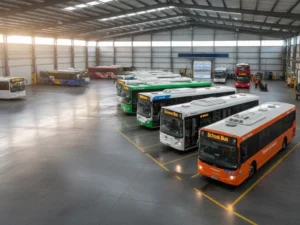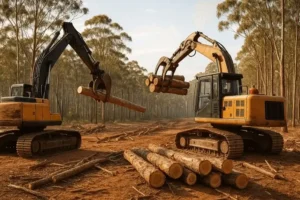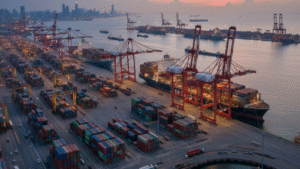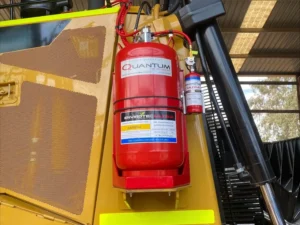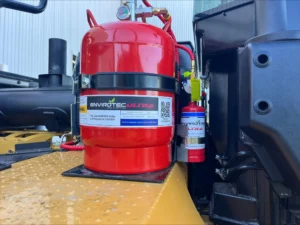The Australian mining industry operates some of the world’s largest and most powerful machinery, with operations running 24/7 in extreme conditions. Fires on mine sites are not just inconvenient—they pose a serious threat to worker safety, equipment, and operational continuity. According to industry reports, fire incidents remain one of the leading causes of downtime in mining, often resulting in millions of dollars in damages and lost productivity.
One of the biggest risks comes from mobile mining equipment, which relies on multiple diesel engines, hydraulic systems, and high-powered electrical components. These machines work under high temperatures, dusty environments, and long operating hours, all of which increase the likelihood of fires. A single uncontrolled fire on a mine site can lead to catastrophic consequences, including:
- Loss of expensive equipment that is difficult to replace due to supply chain delays.
- Operational shutdowns, delaying production and impacting profitability.
- Serious safety risks for workers, especially in underground mining environments.
To prevent fires from spreading and causing irreversible damage, mining companies are increasingly investing in mining fire suppression systems, ensuring that their critical assets remain protected at all times.

Why Heavy Equipment is Prone to Fire Hazards
Heavy machinery operates in some of the most extreme conditions, making it highly susceptible to fire risks. Key factors that contribute to equipment fires include:
- High Operating Temperatures – Mobile machinery runs hot for long hours, increasing the risk of engine overheating and fuel ignition.
- Flammable Liquids – Diesel fuel, hydraulic oils, lubricants, and solvents increase the likelihood of fires spreading once ignited.
- Electrical Failures – Short circuits, damaged wiring, and battery malfunctions can cause fires, particularly in forestry, mining, and construction industries.
- Remote Worksites – Fires in isolated locations make emergency response slow or unavailable, increasing the importance of automatic fire suppression.
With these risks in mind, having a reliable foam fire suppression system in place is critical for fire prevention and asset protection.
Why Mining is One of the Highest-Risk Industries for Fires
Mining operations involve multiple high-risk fire hazards that make the industry uniquely vulnerable to fire incidents. The key risk factors include:
1. Mobile Equipment Fires
Heavy mining machinery—such as haul trucks, bulldozers, and excavators—operates continuously under extreme heat and high mechanical stress. Diesel engines run hot for hours, and fuel and hydraulic lines are under high pressure. If a leak occurs near a hot turbocharger or exhaust system, a fire can ignite within seconds.
2. Underground vs. Surface Mining Fire Risks
In underground mines, fires are particularly dangerous due to confined spaces, poor ventilation, and limited escape routes. Even small fires can cause toxic smoke buildup, making evacuation difficult.
In surface mining, while open-pit mines have better airflow, fires involving large machinery and fuel storage areas still pose significant risks.
3. Electrical and Mechanical Failures
Electrical fires are common in control rooms, processing plants, and conveyor systems, where short circuits or faulty wiring can cause overheating. Mechanical failures, such as friction in conveyor belts, can generate enough heat to ignite fires, particularly in dusty environments.
4. Fuel and Chemical Storage Hazards
Mines store large quantities of diesel fuel, lubricants, and chemical reagents, all of which are highly flammable. Fire suppression is critical in workshops, substations, and fuel depots, where accidental fuel spills can lead to rapidly spreading fires.
Without an effective fire suppression system, these hazards put mining operations at risk, leading to downtime, damage, and safety incidents.
Mining Industry Fire Safety Regulations & Compliance
Australian mining companies must adhere to strict fire safety regulations to minimise risks and ensure compliance with industry standards.
Failing to install fire suppression systems can result in fines, shutdowns, or legal penalties. Proper fire suppression reduces insurance costs and helps mining companies meet workplace safety obligations.
Envirotec’s Industry-Leading Mining Fire Suppression Solutions
Envirotec leads the industry in mining fire suppression solutions with our three key mobile fire suppression products. Here is what they can do:
Envirotec Innov8
- A compact and durable fire suppression system designed for underground mining equipment.
- Ideal for confined spaces where traditional suppression systems may be too large.
Envirotec 360
- A heavy-duty fire suppression solution built for large mobile mining equipment, including haul trucks and loaders.
- Utilises Advanced F3 Foam Technology, ensuring fast and reliable fire suppression.
Envirotec Ultra
- A cost-effective, long-lasting system designed to reduce operational costs.
- Features fluorine-free foam technology, making it safer for the environment and human health.
- Foam lasts up to five years, reducing maintenance frequency and costs.
Envirotec’s fire suppression solutions are engineered for mining environments, ensuring safety, compliance, and cost savings.
Prioritising Fire Safety in Mining Operations
Mining operations cannot afford to underestimate fire risks. Fires in mobile equipment, underground operations, and fuel storage areas can result in severe losses, regulatory penalties, and safety hazards.
Investing in fire suppression systems is a proactive step toward preventing costly fire-related shutdowns and protecting expensive mining assets.
With advanced foam fire suppression systems, Envirotec provides the most effective fire protection for mining operations.
Contact Envirotec today to learn more about tailored fire suppression solutions for your site.






